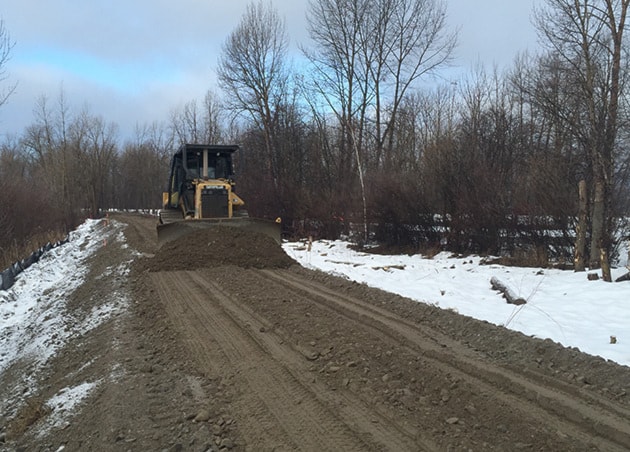Over the course of a 45 year engineering career, Don Dobson has spent a lot of time working with rivers and streams, working to control flows.
Much of the work in the early part of his career was spent containing water flows in places like Chilliwack and Steveston, where he worked on dikes on the Fraser River.
But now Dobson is seeing a significant change in his work and it's directly happening here in Kelowna as a large group of community partners works to try to restore Mission Creek to a more natural flow.
"It's kind of neat," said Dobson, whose crew has moved one of the original dikes on Mission Creek down from the Casorso Bridge. "The engineering approaches we used in the past—which were very good from an engineering perspective of putting in works that will contain the flow—have changed. Now we've learned that there are better ways to do things. Now I'm going back in, in the latter part of my career, and actually moving dikes away from the creek, working with the creek instead of fighting it."
In this case, Dobson is working on a stretch of Mission Creek with several groups including the City of Kelowna, the regional district and the province, the Friends of Mission Creek, the Okanagan Nation Alliance, the Westbank First Nation and the Central Okanagan Land Trust. Together those groups make up the Mission Creek Restoration Initiative (MCRI) and plan monthly how to restore Mission Creek back to its original flows. Originally as it entered East Kelowna, Mission Creek would have wandered and meandered for 33 kilometres before dumping into Okanagan Lake. As the city developed and dikes were built to control the flow, the creek was changed and now hurtles over the same stretch of land in just 11 kilometres.
But things are starting to change and the Mission Creek Restoration Initiative is nearly complete the first phase of restoring Mission Creek closer to its historical route. Working on a 800 metre stretch from the Casorso Bridge downstream, the south-side dike has been moved, increasing the width between the dikes on either side of the creek from about 40 metres to about 140 metres wide. That will allow Mission Creek to meander and more naturally flow as opposed to the water careening down a straight line towards Okanagan Lake.
"It's important to make sure people understand we have not done anything with regard to changing the main channel," Dobson explained. "The main channel you see while you're standing on the Casorso Bridge will remain like that so during (spring) freshet, when large volumes of water need to move through to the lake, it can do that efficiently. The channel you see will still be there but it will also have the opportunity to widen out and become more natural."
The widening of Mission Creek is going to be a long process that can only take place when land-owners near the creek agree to partner with the MCRI. In this case MCRI, led by the City of Kelowna, purchased the first parcel of land from the Casorso family in 2012. The next parcel followed and by 2014 the group partnered with engineering students at UBC Okanagan who worked on the design of the new dike.
Construction began last year and as of this week it is largely complete with finishing work on the dike and clean-up still to take place and in the summer (when allowed by the Department of Fisheries) more work will take place to help create a few meanders.
At the City of Kelowna, Todd Cashin is the man in charge of the project. Also involved with local fishery group Trout Unlimited Okanagan, Cashin first began working towards the restoration of Mission Creek in 2001 when he worked for the regional district. But it was spring of 2007 when Mission Creek saw flood levels hit a 50-year high that really signified it was time to get to work. By 2012 and '13 three separate flood events occurred on Mission Creek as water levels reached unprecedented levels.
It's this flooding that is the main reason for the work, along with creating better habitat for fish, and wild creatures living along the creek, said Cashin.
"Absolutely everyone benefits from Mission Creek whether it's in your homes with water quality, helping out irrigation for agriculture and supporting rainbow and kokanee fish stocks and species at risk," said Cashin. "That stuff is all really important but in my mind what's more important, with climate change as the big train coming at us, is Kelowna is on a flood plain. We've seen flooding in other communities and we need to pay attention to that. Moving the dikes back and giving the creek some more room is an important first step."
There are many funding partners helping to make the restoration of Mission Creek possible. The City of Kelowna had set aside $1.4 million to help with property acquisition while two major grants gave the project a serious push as MCRI and its partners were awarded a $250,000 grant from DFO and a $380,000 grant from the Habitat Conservation Trust Fund. Local fish and game clubs have gotten into the act with Trout Unlimited donating $5,000, the Peachland Sportsmen's Association $5,000 and the Oceola Fish and Game Club $7,500, just to name a few of the many partners.
"We've been pretty successful in taking money and leveraging it for additional dollars," said Cashin. "We're quite happy with what's happening out there with this project. There are other pots of money out there and you need to show you are well organized and have the ability to take on these projects. I get goose bumps talking about this project. On one hand it has taken a long time…but to actually see on the ground work is amazing. I'm just hoping the snowball gets bigger. and this really gets going."
